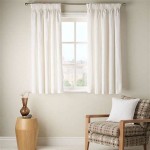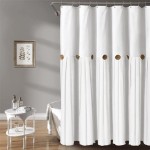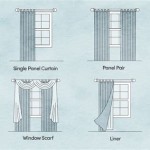How To Install Blackout Curtains Without Drilling
Blackout curtains are functional window treatments designed to block a significant amount of light from entering a room. They are particularly useful in bedrooms, nurseries, or home theaters where minimizing light exposure is desirable. While traditional installation methods involve drilling holes to mount curtain rods, alternative techniques exist that allow for secure and damage-free installation. This article provides a comprehensive guide on how to install blackout curtains without drilling, outlining various methods, considerations, and best practices.
Choosing the right method for no-drill installation depends on several factors, including the type of window frame, the weight of the curtains, and the desired aesthetic. Understanding these factors is crucial to ensuring a successful and long-lasting installation.
Understanding Blackout Curtain Weight and Window Frame Material
The weight of the blackout curtains is a significant consideration when choosing a no-drill installation method. Blackout curtains are typically heavier than standard curtains due to the additional layer of light-blocking fabric. Lighter curtains may be suitable for temporary adhesive solutions, while heavier curtains require more robust support mechanisms.
The material of the window frame also influences the choice of installation method. Metal frames are often compatible with magnetic rods, while wooden frames can accommodate pressure rods or adhesive solutions. Vinyl frames may require specialized adhesives to ensure a secure bond. Before proceeding with any installation, it is essential to assess the frame material and choose a compatible hardware solution.
Failure to consider the weight and frame material can lead to installation failures, such as rods detaching from the wall or damage to the window frame. Careful consideration of these factors is essential for a successful and damage-free installation.
Adhesive Rods and Hooks: A Temporary Solution
Adhesive rods and hooks offer a simple and temporary solution for installing blackout curtains without drilling. These products typically utilize strong adhesive strips or pads that attach directly to the window frame or wall. They are suitable for lightweight blackout curtains and are ideal for renters or individuals who prefer a non-permanent installation.
Prior to installation, thoroughly clean the surface of the window frame or wall with isopropyl alcohol to remove any dirt, grease, or residue. This ensures optimal adhesion. Allow the surface to dry completely before applying the adhesive strips or pads.
Position the adhesive rods or hooks according to the manufacturer's instructions. Apply firm and even pressure for the recommended duration to ensure a secure bond. Allow the adhesive to cure for the specified time before hanging the curtains. This curing period allows the adhesive to fully bond to the surface, maximizing its holding power.
While adhesive rods and hooks are convenient, they may not be suitable for heavy blackout curtains or high-traffic areas. Regularly inspect the adhesive for signs of loosening or degradation and reinforce as needed. Consider the climate conditions in the area as extreme temperatures can affect the strength of the adhesive. In humid environments, the adhesive may weaken over time, requiring periodic replacement.
Tension Rods: Versatile and Adjustable
Tension rods offer a versatile and adjustable solution for installing blackout curtains within a window frame or doorway. These rods utilize internal springs to create pressure against the surrounding surfaces, providing a secure and stable mounting point without the need for drilling. Tension rods are available in various lengths and thicknesses to accommodate different window sizes and curtain weights.
To install a tension rod, measure the width of the window frame or doorway where the curtains will be hung. Choose a tension rod that is slightly longer than the measured width. Extend the rod to the desired length, ensuring that it is slightly longer than the opening.
Position the tension rod within the window frame or doorway, ensuring that it is level and centered. Gradually release the tension mechanism, allowing the rod to expand and create pressure against the surrounding surfaces. Test the rod's stability by gently pulling on it. If the rod feels loose or unstable, adjust the tension mechanism until it is securely in place.
Tension rods are suitable for lightweight to medium-weight blackout curtains. For heavier curtains, select a thicker and more robust tension rod. Consider using rubber or silicone grips on the ends of the rod to prevent slippage and protect the window frame from damage. Regularly inspect the tension rod for signs of loosening or slippage and readjust as needed.
When selecting tension rods, consider the design of the rod ends. Some tension rods have flat ends, while others have rounded or contoured ends. Choose a design that complements the style of the curtains and the window frame. Ensure that the rod ends are made of a non-marring material to prevent scratches or damage to the window frame.
Magnetic Curtain Rods: Ideal for Metal Frames
Magnetic curtain rods are specifically designed for use with metal window frames. These rods utilize strong magnets to attach directly to the metal surface, providing a secure and damage-free installation. Magnetic curtain rods are particularly well-suited for steel or iron window frames and are available in various lengths and styles.
Before installing a magnetic curtain rod, ensure that the window frame is made of a ferromagnetic material that will attract magnets. Test the frame with a small magnet to confirm its compatibility. Clean the surface of the window frame with a damp cloth to remove any dirt or debris that could interfere with the magnetic bond.
Position the magnetic curtain rod on the window frame, ensuring that the magnets are in full contact with the metal surface. Apply gentle pressure to secure the rod in place. Test the rod's stability by gently pulling on it. If the rod feels loose or unstable, reposition it and apply more pressure. Ensure that the magnets are evenly distributed along the length of the rod to maximize its holding power.
Magnetic curtain rods are suitable for lightweight to medium-weight blackout curtains. For heavier curtains, select a magnetic curtain rod with stronger magnets. Consider using multiple magnetic rods to distribute the weight of the curtains more evenly. Regularly inspect the magnetic rods for signs of corrosion or weakening of the magnets and replace as needed.
When selecting magnetic curtain rods, consider the design of the magnets. Some magnetic rods have exposed magnets, while others have magnets that are encased in a protective coating. Choose a design that is both functional and aesthetically pleasing. Ensure that the magnets are made of a high-quality material that will resist corrosion and maintain their magnetic strength over time.
Command Hooks: A Versatile Adhesive Option
Command Hooks are a popular and versatile adhesive solution for hanging various items, including lightweight blackout curtains. These hooks utilize removable adhesive strips that attach securely to a variety of surfaces, including painted walls, wood, and glass. Command Hooks are available in various sizes and weight capacities, making them a suitable option for different curtain weights.
Before installing Command Hooks, thoroughly clean the surface of the wall or window frame with isopropyl alcohol to remove any dirt, grease, or residue. Allow the surface to dry completely before applying the adhesive strips. Select the appropriate size and weight capacity of Command Hooks based on the weight of the blackout curtains.
Attach the adhesive strips to the back of the Command Hooks, following the manufacturer's instructions. Position the hooks on the wall or window frame, ensuring that they are level and evenly spaced. Press firmly on each hook for the recommended duration to ensure a secure bond. Allow the adhesive to cure for the specified time before hanging the curtains. This curing period allows the adhesive to fully bond to the surface, maximizing its holding power.
Command Hooks are suitable for lightweight blackout curtains. For heavier curtains, consider using multiple hooks to distribute the weight more evenly. Ensure that the hooks are placed in a location that can support the weight of the curtains without damaging the wall or window frame. Regularly inspect the hooks for signs of loosening or degradation and replace as needed.
When selecting Command Hooks, consider the design of the hooks. Some Command Hooks have a smooth, rounded design, while others have a more decorative design. Choose a design that complements the style of the curtains and the room. Ensure that the hooks are made of a durable material that will withstand the weight of the curtains over time.
No-Drill Curtain Rod Brackets: Innovative Solutions
No-drill curtain rod brackets represent an innovative solution for installing curtain rods without drilling. These brackets utilize various mechanisms, such as clamps, springs, or adhesives, to attach securely to the window frame or wall. They are designed to accommodate standard curtain rods and provide a stable and secure mounting point for blackout curtains.
Before installing no-drill curtain rod brackets, carefully read and understand the manufacturer's instructions. Ensure that the brackets are compatible with the type of window frame and the weight of the blackout curtains. Clean the surface of the window frame or wall with isopropyl alcohol to remove any dirt, grease, or residue. Allow the surface to dry completely before installing the brackets.
Position the no-drill curtain rod brackets on the window frame or wall, following the manufacturer's instructions. Apply firm and even pressure to secure the brackets in place. If the brackets utilize clamps or springs, ensure that they are properly adjusted to provide a secure grip. If the brackets utilize adhesives, allow the adhesive to cure for the specified time before hanging the curtains.
No-drill curtain rod brackets are available in various designs and weight capacities. Select brackets that are suitable for the weight of the blackout curtains and the style of the room. Consider using multiple brackets to distribute the weight of the curtains more evenly. Regularly inspect the brackets for signs of loosening or damage and replace as needed.
When selecting no-drill curtain rod brackets, consider the adjustability of the brackets. Some brackets are adjustable to accommodate different window frame thicknesses or curtain rod diameters. Choose brackets that offer the flexibility to customize the installation to your specific needs. Ensure that the brackets are made of a durable material that will withstand the weight of the curtains over time.
By understanding the various methods and considerations outlined in this article, it is possible to install blackout curtains without drilling, achieving a functional and aesthetically pleasing result while preserving the integrity of the window frames and walls.

How To Hang Curtains Without Drilling

5 Easy Ways To Hang Curtains Without Drilling

5 Easy Ways To Hang Curtains Without Drilling

Ingenious Ways To Hang Curtains Without Drilling Holes

How To Hang Curtains Using Command Hooks The Happier Homemaker

5 Easy Ways To Hang Curtains Without Drilling

Step By Guide How To Install Blackout Curtains Over Blinds Sleepout

Hang Curtains Without Drilling With These Tips

5 Easy Ways To Hang Curtains Without Drilling

Er Friendly Curtains How To Hang Them Without Drilling Draper And Kramer Incorporated








